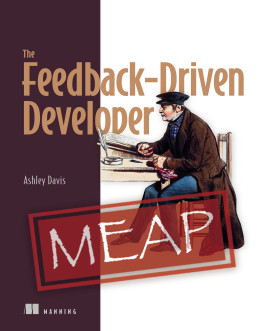pro $24.99 per month
- access to all Manning books, MEAPs, liveVideos, liveProjects, and audiobooks!
- choose one free eBook per month to keep
- exclusive 50% discount on all purchases
- renews monthly, pause or cancel renewal anytime
lite $19.99 per month
- access to all Manning books, including MEAPs!
team
5, 10 or 20 seats+ for your team - learn more

Look inside
Design principles and patterns for building better Python software.
Great Python applications take advantage of established design principles and patterns that maximize performance, maintainability, and reliability. Software Design for Python Programmers shows you how to build on your Python coding skills by mastering the practices of great software design! Following intuitive “before” and “after” examples of improved code, you’ll learn to plan and execute Python applications effectively and avoid bugs associated with unmanaged state, poorly-formed classes, inflexible functions, and more.
In Software Design for Python Programmers, you’ll learn how to:
Software Design for Python Programmers teaches you to apply tried-and-tested object-oriented design principles to your Python code. The examples in this guide are simple, clear, and accessible. All examples are in Python, although most of the techniques will apply to any object-oriented language. You’ll solve common architecture problems, and discover the “Pythonic” way to implement encapsulation, implementation-hiding, method overloading, and more.
Great Python applications take advantage of established design principles and patterns that maximize performance, maintainability, and reliability. Software Design for Python Programmers shows you how to build on your Python coding skills by mastering the practices of great software design! Following intuitive “before” and “after” examples of improved code, you’ll learn to plan and execute Python applications effectively and avoid bugs associated with unmanaged state, poorly-formed classes, inflexible functions, and more.
In Software Design for Python Programmers, you’ll learn how to:
- Acquire and analyze application requirements
- Create well-designed applications through iterative development
- Design Python classes with high cohesion and loose coupling
- Implement Python decorators to enhance class properties, abstraction, and method functionality
- Apply industry-standard design principles to improve code structure and maintainability
- Identify appropriate design patterns to solve complex software design challenges
Software Design for Python Programmers teaches you to apply tried-and-tested object-oriented design principles to your Python code. The examples in this guide are simple, clear, and accessible. All examples are in Python, although most of the techniques will apply to any object-oriented language. You’ll solve common architecture problems, and discover the “Pythonic” way to implement encapsulation, implementation-hiding, method overloading, and more.
about the book
Software Design for Python Programmers helps you build software like the pros. In clear, jargon-free language it lays out the object-oriented design principles, practices, and patterns that you need to know to build scalable and maintainable applications. Throughout, you’ll find intuitive “before” and “after” examples that show you what bad code looks like, and how to fix it with the right pattern. Conversation sidebars feature engaging talking heads that ask-and-answer common questions. If you know the basics of Python code and are ready to make the leap to building software, this book will be the patient and insightful mentor you need!about the reader
For programmers comfortable with Python syntax. No experience with object-oriented software design required.Every developer designs software, but few have a design process, and fewer still have a set of core principles to guide that process. This is a critical skillset that is lacking among most software developers. I think it's an absolutely essential book that fills a critical need.
The book does a great job of making complex software design principles accessible. The use of examples, diagrams, and real-world scenarios helps simplify the concepts, making them easier to grasp, especially for those new to the subject.
choose your plan
team
monthly
annual
$49.99
$399.99
only $33.33 per month
- five seats for your team
- access to all Manning books, MEAPs, liveVideos, liveProjects, and audiobooks!
- choose another free product every time you renew
- choose twelve free products per year
- exclusive 50% discount on all purchases
- renews monthly, pause or cancel renewal anytime
- renews annually, pause or cancel renewal anytime
-
![]() Software Design for Python Programmers ebook for free
Software Design for Python Programmers ebook for free
choose your plan
team
monthly
annual
$49.99
$399.99
only $33.33 per month
- five seats for your team
- access to all Manning books, MEAPs, liveVideos, liveProjects, and audiobooks!
- choose another free product every time you renew
- choose twelve free products per year
- exclusive 50% discount on all purchases
- renews monthly, pause or cancel renewal anytime
- renews annually, pause or cancel renewal anytime
-
![]() Software Design for Python Programmers ebook for free
Software Design for Python Programmers ebook for free




















 Software Design for Python Programmers ebook for free
Software Design for Python Programmers ebook for free